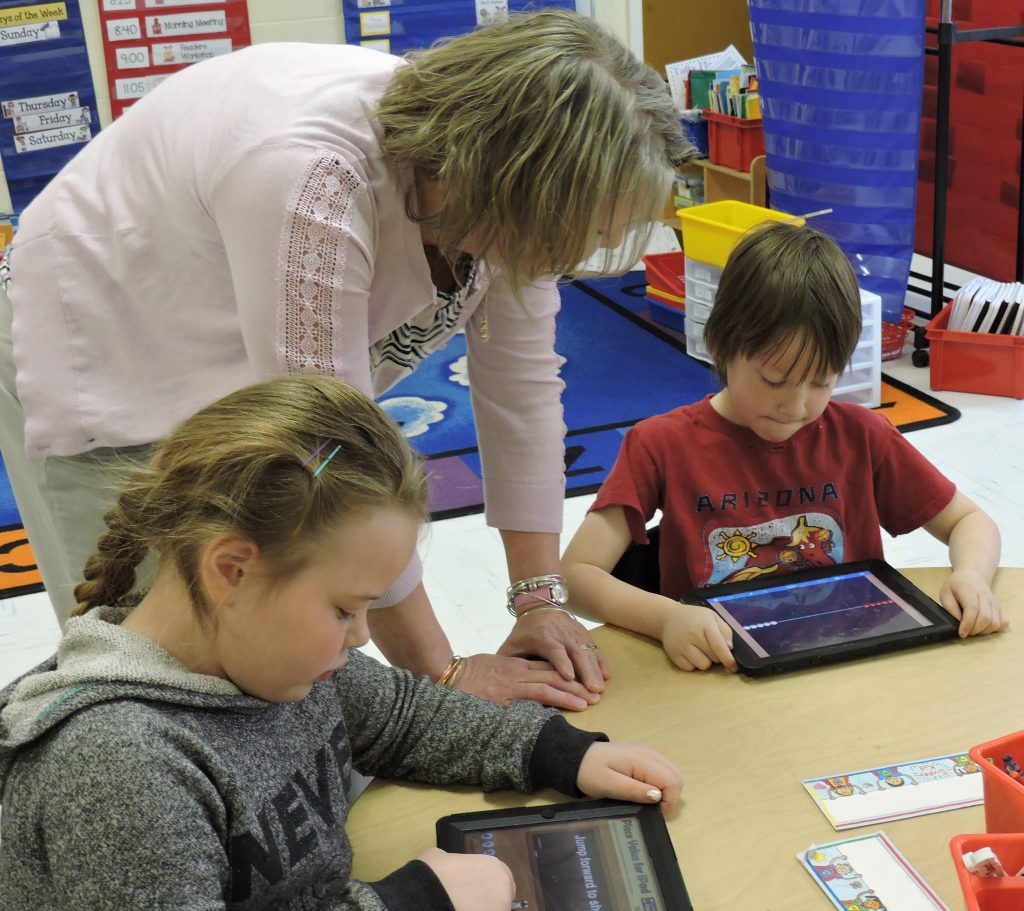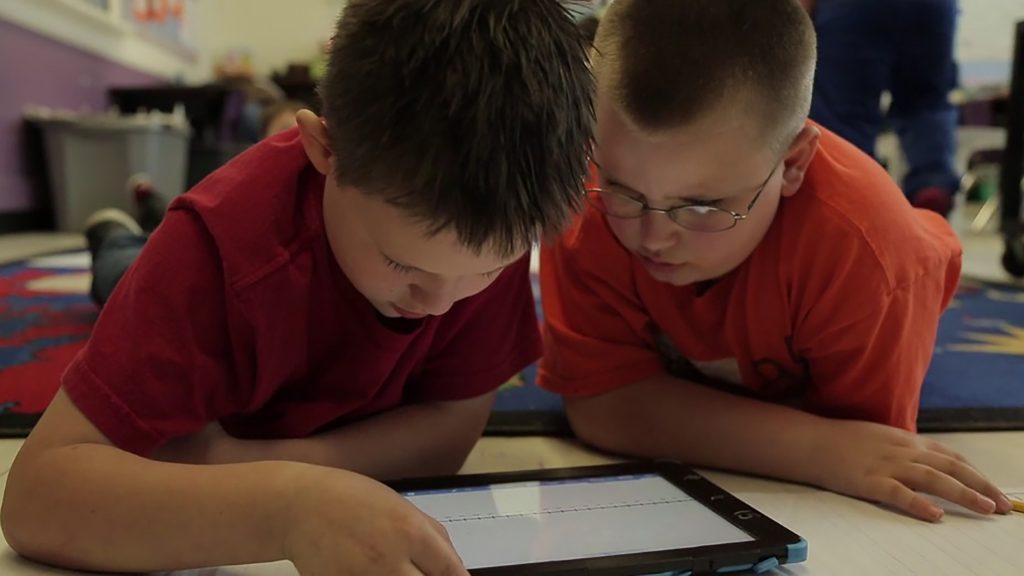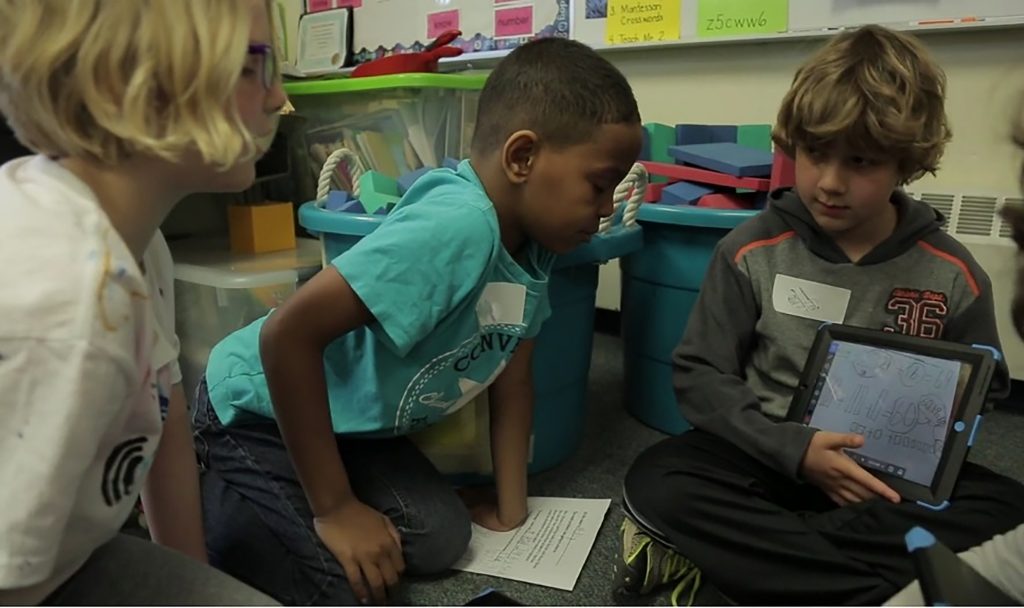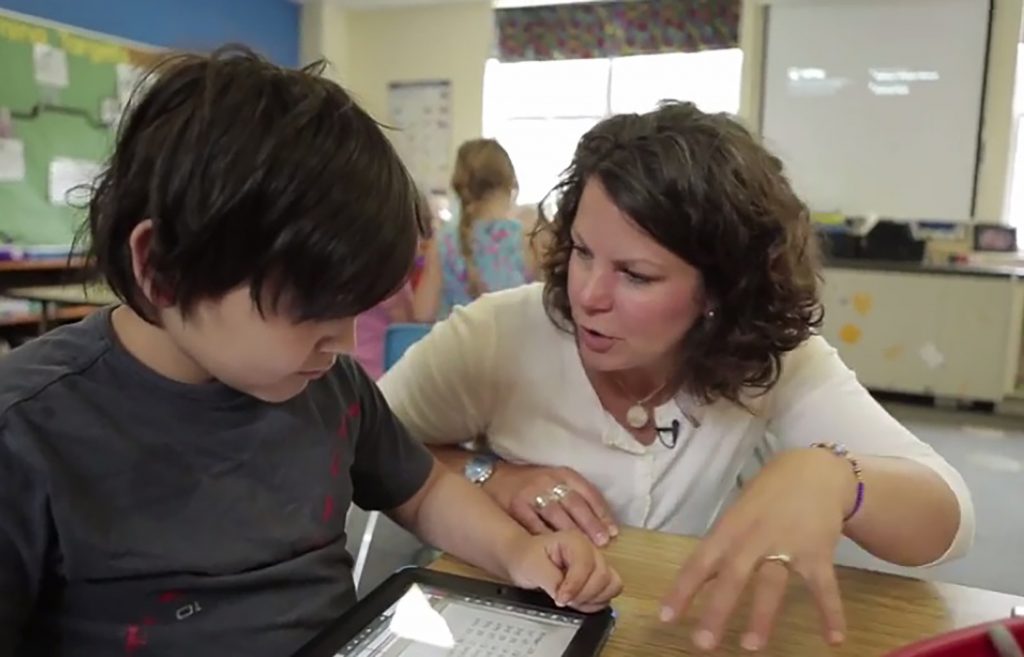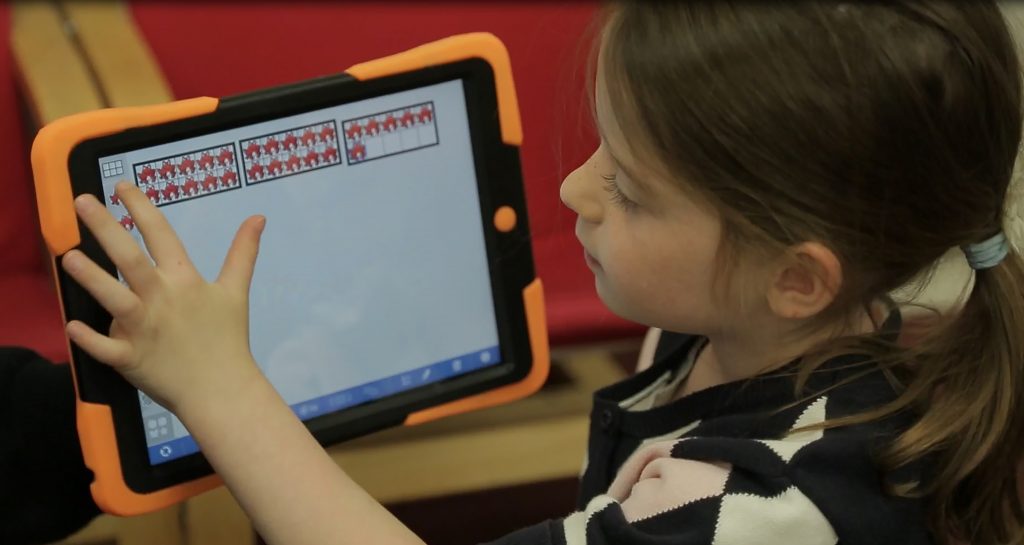Research to Practice, Practice to Research
A Screencasting Strategy to Support STEM Learning in the Early Grades
Connected Science Learning October-December 2017 (Volume 1, Issue 4)
By Josephine Louie, Pamela Buffington, and Jennifer Stiles
Learn how a research–practice partnership used screencasting to promote early elementary students’ mathematics learning and communication.
It is a winter day in Auburn, Maine. Twenty second-grade students in Ms. M’s classroom pull out individual iPads that the school district has supplied for all students in grades K–2. Ms. M poses the following scenario and question to her students: The school’s gym teacher is introducing a new game to first and second graders. They need 91 balls to play the game. How many balls could be small, how many could be medium, and how many could be large?
Following Ms. M’s instructions, the classroom buzzes with conversation as students devise answers on their iPads using Explain Everything, an app that offers each student an interactive whiteboard space for visually representing and writing their mathematics solution strategies. With flexible multimedia capabilities, the app allows students to import photos, videos, and digital modeling tools to help them think through and illustrate their answers. The app also allows students to create audiovisual recordings, or screencasts, of everything they do on their screens and say aloud as they work out their solutions.
Students in Ms. M’s class make their recordings and then share them with one or two other classmates. A small group of students—Aliyah, Jessica, and Ollie (all names in this article are pseudonyms)—sit on a rug and watch Jessica’s recording on her iPad. After they watch, they comment and ask each other questions. Aliyah says, “I liked that you have friendly numbers.” Ollie echoes her compliment. Aliyah then continues: “You had 1 small ball … you had 81 medium … and 9 big. So my question is: Why is 81 the biggest number in all of them?” Jessica responds: “Well, the numbers don’t have to go with certain balls … I guess I just chose medium.” Ollie then has a revelation: “Oh, I get what you did … it’s like 1 plus 9 equals 10 and then you had 81 and that was 91. I like that.”
During this conversation, a researcher captures the small group’s interaction on video (Figure 1). The teacher is circulating elsewhere in the classroom, observing other paired and small-group interactions and posing questions to help deepen students’ mathematical thinking and reflection. Aliyah, Jessica, and Ollie are independently sharing solution strategies, observing what is unique about their approaches, and supporting each other’s thinking. Through this type of mathematical exchange, they are developing a fundamental mathematical practice described by the Common Core State Standards, Mathematics (CCSS Mathematics): “Construct viable arguments and critique the reasoning of others” (NGAC and CCSSO 2010, p. 6). These students have handouts and classroom posters with sentence starters and phrases (e.g., “This is what I noticed …” and “I know my answer is correct because …”) to help prompt dialogue and their own self-reflection when making and reviewing their recordings. Ms. M collects all students’ screencasts and can review and discuss specific recordings further with students the next day.
Figure 1
Students in Ms. M’s second-grade class work in small groups to share solution strategies and support each other’s mathematical thinking.
A Research–Practice Partnership Focused on Improving Early Mathematics Learning
This student scene, and others like it, came about through Ms. M’s participation in a research–practice partnership between the Education Development Center (EDC), local mathematics education faculty from the University of Maine at Farmington (UMF) and the University of Southern Maine (USM), and the Auburn School Department (ASD). Launched in early 2014, the partnership addresses low mathematics achievement in early elementary students in Auburn. (For more information on the partnership and its work, see Interactive STEM.) Auburn is a small city and former mill town in west-central Maine, where a majority (54%) of students qualify for free or reduced price lunch (NCES 2015). For many years, students entered kindergarten with significant gaps in literacy and mathematics readiness skills. In 2011 the district implemented a one-to-one iPad initiative to support more customized student instruction and to improve students’ literacy and mathematics achievement scores. Although improvements were made in literacy, early elementary students’ mathematics achievement scores remained low. When researchers from EDC approached ASD leaders to form a research–practice partnership (RPP), district leaders agreed to use a collaborative approach to explore the problem more deeply and develop potential solutions.
The EDC partners who helped form the Auburn RPP were part of the Research + Practice Collaboratory, a project funded by the National Science Foundation to explore new approaches to bridging the gap between research and practice in STEM education through partnerships in both school and out-of-school settings. EDC and ASD pursued a partnership approach under the theory that researchers and practitioners who collaborate closely can generate education reforms that are more sustainable and scalable than those designed by researchers or practitioners alone (Penuel et al. 2011).
Initial Collaborative Learning Among Partners
The Auburn RPP began with a team of four researchers and professional learning experts from EDC, two mathematics education faculty from UMF and USM, five ASD district administrators, three principals, and nine K–2 teachers from the three lowest-performing elementary schools in the district. The partnership organized its collaboration around the four principles of design-based implementation research (Penuel et al. 2011), which are:
- “a focus on persistent problems of practice from multiple stakeholders’ perspectives”;
- “a commitment to iterative, collaborative design”;
- “a concern with developing theory related to both classroom learning and implementation”; and
- “a concern with developing capacity for sustaining change in systems” (p. 332).
Following these principles, the Auburn RPP identified a persistent problem of practice that partners could address together. Early elementary teachers from the district described two main challenges they faced in supporting students’ mathematical learning. First, multiple teachers noted that they did not know the best ways to promote students’ numerical fluency and basic number and operation skills, which were weak among students in the early elementary grades. Second, many teachers agreed that they did not have a clear understanding of what effective mathematics instruction could look like for young children when using one-to-one iPads in the classroom. To gain greater insight into these concerns, EDC researchers conducted observations of mathematics lessons in early elementary classrooms. There, they saw students typically using iPads by themselves, wearing headphones, for supplemental drill-and-practice exercises—with few opportunities to engage in rich problem-solving activities or mathematical discourse.
In response to these needs and challenges, EDC and Maine university researchers helped the district design and facilitate a 35-hour professional learning experience in summer 2014. The experience consisted of workshops and online activities (see links to sample resources here) in which all partners studied and discussed research on early mathematics learning trajectories (Clements and Sarama, 2014; Confrey, Maloney, and Corley 2014; Fosnot and Dolk 2001), research-based digital modeling apps designed to support mathematical reasoning and problem solving, and screencasting tools such as Explain Everything. Teachers then spent the fall exploring new tools and strategies in their classrooms. They documented their experiences and observations, and gathered monthly with all partners during professional learning community meetings to share and reflect on their efforts (see Appendix A in Resources).
The RPP’s Research Question and Methods
Following this period of initial exploration, the partners developed a student learning strategy to coinvestigate. Multiple teachers observed that students were highly engaged when using screencasting to make audiovisual recordings of themselves solving mathematics problems. The teachers and researchers posed the following research question: If students in early grades regularly use a screencasting app such as Explain Everything to record explanations of their thinking when solving mathematics problems, will they show improvement in their mathematical problem-solving skills and communication (Figure 3)?
Figure 3
Students use Explain Everything to record, review, and discuss how they solved a mathematics problem.
The teachers agreed to explore this research question together. They engaged in 30-day, iterative coinvestigation cycles in which they asked their students to use screencasting to explain, record, and review their process when completing a mathematics task. Through a strategy planning form, an online log that mirrored the questions in the strategy planning form, and regular surveys, teachers documented how they implemented this strategy with students (such as in small groups, in pairs, or individually), and how students responded to different implementation approaches. During monthly professional learning community meetings, teachers shared student screencasts and group members offered observations and ideas for further testing (see the sharing protocol that was used during group discussions and a tool that a teacher created and refined over time). Coinvestigation cycles continued through the spring, when small, school-based teams of researchers and administrators visited classrooms to help collect observation data and student media recordings. Over the summer, a new cohort of nine teachers from Auburn’s three other elementary schools joined the group and coinvestigation of the screencasting strategy was extended through the following academic year. During this period, EDC researchers also conducted interviews with teachers, administrators, and researchers to gather more in-depth data on the types of changes that partners were observing in early mathematics learning due to the group’s testing efforts.
Findings: Improved Mathematics Learning Among Students
Data collected through interviews with Auburn educators, classroom observations, and student screencasts suggest that the screencasting strategy supported growth in students’ mathematics learning. Following regular use of the strategy, partners observed students displaying stronger mathematical reasoning and metacognition, richer mathematical communication and discourse, and more flexible mathematical thinking that can transfer to everyday, out-of-school settings. The strategy also provided more equitable opportunities for students of all backgrounds to engage in rigorous mathematical tasks. All of these outcomes are aligned with learning goals from the CCSS Mathematics.
Stronger Mathematical Reasoning and Metacognition
In interviews, multiple teachers said that based on their observations, the screencasting strategy helped students develop deeper understandings of early mathematics concepts and recognize the mathematical reasoning of others. Observations by teachers and research partners suggest that the screencasting app may have given students an engaging way to observe and reflect on their own and their peers’ mathematical thinking. For example, a second-grade teacher observed that when her students reviewed others’ screencasts, “They’re listening to somebody else’s video, so they’re thinking about what the other person is doing. So, often they’ll jump in [and say]: ‘Oh, I can see you added the 9 and the 1 in the tenth column, and that’s how you got 100,’ and they start to make those connections” (interview, March 2, 2016). Another second-grade teacher reported what she heard from other teachers in the partnership: “Their students are looking at their work and they’re making the corrections and they’re pointing out each other’s mistakes and they’re doing it in a respectful way. The other teachers just seem very happy … they’re seeing this growth in their students with math” (interview, January 26, 2016). A math coach also described her thoughts about how the screencasting strategy may have helped to advance students’ awareness of their own thinking and metacognition: “When they’re doing their work and recording, and then they go back and listen, they can either deepen their understanding, or be reflective [as they self-correct]. They can say, ‘Oh, wait a minute. I meant this.’ And within that piece, [they] may also clarify a misunderstanding they may have had” (interview, January 27, 2016).
Richer Communication and Discourse
Teacher interviews and observations among partners suggest that by giving students an opportunity to express, hear, and share their own voices when solving problems, the screencasting strategy helped promote richer dialogue about mathematics. One teacher explained: “In the past, my kids have said, ‘Well, this is how I did it.’ Or, ‘I just knew it,’ and they don’t discuss anymore. This year, they’re having discussions and talking about their thinking and responding to others” (interview, January 26, 2016). After a semester of testing the screencasting strategy, school-based coinvestigation teams no longer saw students using their iPads with headphones to silently practice drills by themselves. Researchers more often saw students grouped around their devices, engaging in mathematical discussions. One teacher noted:
I’ll find now … students will … just be engaging in conversation while I’m writing something up on the board and it’s about a math problem. And they’re arguing with each other but being really reasonable and they’re doing those things that we’re practicing but without that scaffold of [using] the [screencasting] video. Which I think is really the goal. I feel like the videos are a stepping stone toward just having [regular] math conversations with each other (interview, February 2, 2016).
Figure 5
Students work in small groups to explain their thinking while classmates critique their mathematical reasoning.
More Equitable Mathematics Learning Opportunities for All Students
Multiple teachers and administrators observed that the recording strategy promotes greater equity in mathematics learning, because it gives all students opportunities to express and share their mathematical ideas and have their thinking heard and discussed by others. A principal observed that “you might have kids that have great thinking, but they’re not able to share that because they can’t read or write like their typically developing peers. So [screencasting] evens the playing field for some of those kids who struggle in other areas” (interview, February 1, 2016). A second-grade teacher noted that the recording strategy helped all her students have a voice in the classroom: “I tried [whole-group discussions] and not all students were talking. And there were definitely those students who would get lost in the shuffle … So, what the iPad does is it forces everyone to engage in [a math] problem and everyone to talk” (interview, February 2, 2016).
Several teachers noted that the recording strategy also provided ways for English language learners, students with fine motor and writing difficulties, and students with other learning barriers to engage in mathematical discourse. A kindergarten teacher said:
With my English language learners, sometimes they don’t have the language and the ability to write down what they’re thinking. But if they can use this recording tool and an app, they can show it and talk about what they’ve done a little bit more easily than if [they were using] pencil/paper. Also, I have a very visual class this year, they have to see things and move things … I think that it’s really helpful with those types of kids” (interview, January 26, 2016).
In Ms. M’s second-grade class, the recording strategy was able to draw out words from a student who had previously been nonverbal with all of his teachers. The screencast shown in Figure 6 was the first time any teacher in Auburn had heard the student’s voice. The recording strategy and support from his teacher helped the student begin to speak and share his thinking more regularly with his teacher and classmates throughout the school day.
Figure 6
A second grader who had previously been nonverbal in the classroom uses an iPad to record his problem-solving strategy.
More Flexible Thinking That Transfers
Another benefit of the screencasting strategy, as well as the use of digital modeling tools to support mathematical problem solving, was increased flexibility in students’ mathematical thinking and reasoning. One teacher observed:
And the way my students look at numbers … and the way they’re thinking about solving problems is a lot different than they have in years past … Since we’ve done a lot of work with breaking the numbers apart and using some of those [modeling] apps and the number lines, they have multiple ways they’re solving these problems, multiple ways they’re answering these questions, and then they’re having discussions (interview, January 26, 2016).
The increased flexibility that students demonstrated in class also transferred to problem-solving outside the classroom. A teacher relayed a story of a second-grade student who was shopping for video games with his family. His older brother in fourth grade had a certain amount of birthday money and was trying to decide what to buy. The student offered his brother three possible scenarios: “One was to buy one video game and have some money left over, another was to buy two video games and use all of his money, and a third was to buy three smaller games.” His family was impressed when they realized that his calculations were correct and when he gave a thoughtful explanation of how he arrived at the scenarios. The teacher remarked: “His mom told me his reasoning made so much sense. They were amazed that he could put it all together in his head! This student benefited from the open-ended problems and the opportunity to explain and test his strategies. He is a real problem solver!” (personal communication, 2016).
Findings: Altered Practice Among Teachers
Based on teacher interviews, surveys, and classroom observations conducted by research partners, the screencasting strategy appears to have promoted positive shifts in students’ mathematical outcomes not only directly, but also indirectly by prompting teachers to adopt teaching practices that research has identified as essential for supporting deeper learning in mathematics. These practices include:
- a focus on eliciting and examining students’ thinking;
- use of rich, open tasks that promote reasoning and multiple solution strategies; and
- support for productive struggle among students (Leinwand et al. 2014).
Figure 7
A teacher works with a student to review his screencast and understand how he worked through a math task.
Greater Focus on Students’ Thinking
The screencasting strategy helped teachers gain greater access to students’ thinking and attend more carefully to students’ mathematical reasoning. By regularly collecting dynamic screencasts of students’ problem-solving efforts, teachers gained insights into the thinking of all their students—thinking that may not be clear in the written products or drawings of very young children or in group conversations when some students are more hesitant to speak than others (Figure 8). One teacher noted, “Before, it was one teacher and 20 students, so I didn’t always get to listen to every student … [With the screencasting tool] I can look at those students who I know are struggling and take time to review their recordings later” (interview, February 2, 2016).
Figure 8
In this video, a teacher can see that the student understood the math task and developed a solid strategy, and the incorrect answer was the result of a counting error.
Greater Use of Rich, Open Tasks
Teachers and principals observed that students gained most from the screencasting strategy, and could launch into richer conversations about their recordings, when teachers presented students with open-ended types of problems. Such problems, such as the one shown in Figure 9 or the one that Ms. M posed to her students (described at the beginning of this article), have multiple possible answers and ways of arriving at a solution (Leinwand et al. 2014). After teachers saw the high levels of thinking and discussion that emerged when students used open tasks with the screencasting strategy, they began to incorporate such tasks more regularly into their instruction.
Figure 9
A student uses Explain Everything to record a strategy for making 100.
Greater Support for Productive Struggle
A lesson that emerged for several teachers was the value of allowing students to engage in productive struggle when solving mathematics problems, which is a core standard of the CCSS Mathematics: “Make sense of problems and persevere in solving them” (NGAC and CCSSO 2010, p. 6). The screencasting strategy prompted students to record and review their own explanations when solving a mathematics problem. When students engaged in this strategy as a classroom activity, it was not feasible for teachers to provide help to every student who encountered difficulties solving the problem. The strategy therefore gave students a platform and space to tackle problems on their own, play back and hear their own (and often other students’) thinking, and revise and re-record their explanations. A first-grade teacher noted that the strategy helped her realize that “productive struggle is where kids learn,” as students could often figure out solutions on their own when given a safe space to persevere and self-correct after initial stumbles (interview, January 27, 2016).
Opportunities for Supporting STEM Practices in Multiple Spaces
Based on interview, survey, and classroom observation data, the screencasting strategy developed in Auburn appears to have strengthened mathematics learning among early elementary students by providing a flexible audiovisual platform for students to share their thoughts, ideas, and explanations of how they approach problems and make sense of tasks. The ease with which young learners can use screencasting to draft, review, and redraft their mathematical thinking before sharing with others may help students feel safer taking risks with problem solving and exploring mathematical ideas. Compared to more static paper-and-pencil forms of student work, the dynamic nature of screencasts may help engage students in reviewing and debating their own and other students’ thinking. As media artifacts that make student thinking visible, screencasts can also help teachers focus on where students are in their understandings of mathematical concepts, and then tailor their instruction to students’ needs. The use of screencasting may also help teachers recognize—as teachers did in Auburn—how all students can benefit from opportunities to wrestle with rich, open tasks both individually and in discussion with their peers.
Although the Auburn RPP focused on mathematics learning in early elementary classrooms, partners from the broader Research + Practice Collaboratory project also worked in other STEM disciplines. Insights gleaned from conversations with these partners suggest possibilities for using the screencasting strategy to support student reasoning, communication, and discourse in a variety of STEM settings, such as science. Like the CCSS Mathematics, the Next Generation Science Standards emphasize the importance of developing students’ skills in argumentation and communication through the practices of Engaging in Argument From Evidence and Obtaining, Evaluating, and Communicating Information (NGSS Lead States 2013).
Screencasting also offers opportunities to connect in-school and out-of-school STEM learning. For example, studies have found that students can demonstrate strong interest and engagement in science-related activities outside of the classroom (e.g., Bricker and Bell 2014). With screencasting tools, out-of-school science educators at a summer camp or day visit to an environmental center could ask young children to record their thinking as they examine data that they or others have collected to explain a natural phenomenon (such as why some objects fall to the ground faster than others, or why some objects float or sink in water). Children could make their screencasts at the same time or in turns, depending on the number of devices available. The screencasts could be shared with family when they get home, or with other children at school. Educators in an after-school maker space could encourage children involved in an extended tinkering project to reflect on their learning in screencasts that become an electronic journal. Similar to teachers in Auburn, educators in these settings could organize sessions in which children share their recorded reflections with peers for group discussion.
Teachers in Auburn indicated that the screencasting strategy helped them see strides in student thinking that they had not been able to detect before. Screencasts have the potential to help classroom educators gain insight into STEM-related learning that students pursue outside of school. With such insights, educators may find ways to reinforce or expand upon students’ outside scientific interests in the formal school curriculum. Conversely, screencasts that students make of their science work in school could be shared with out-of-school educators or family members for further discussion or extension.
The growing availability of digital devices with screencasting capabilities, and the appeal that screencasting can hold for young learners, suggests that screencasting may be a powerful tool for supporting the development of important disciplinary practices in multiple STEM fields in early elementary grades. Future research could explore screencasting’s potential to support student learning at later grade levels, in science or engineering classrooms, and in after-school spaces. Following a collaborative approach such as the one used in Auburn, future researchers and educators could also explore possible ways in which screencasting can help students and their teachers see, connect, and strengthen STEM learning across in- and out-of-school settings.
Acknowledgment
This project is supported by the National Science Foundation (grant DRL-1238253). Opinions expressed in this article are those of the authors and not necessarily those of the Foundation.
Josephine Louie (jlouie@edc.org) is a research scientist at Education Development Center in Waltham, Massachusetts. Pamela Buffington (pbuffington@edc.org) is codirector of the Science, Technology, Engineering, and Mathematics Projects Unit at Education Development Center in Waltham, Massachusetts. Jennifer Stiles (jstiles@edc.org) is a research associate at Education Development Center in Waltham, Massachusetts.



